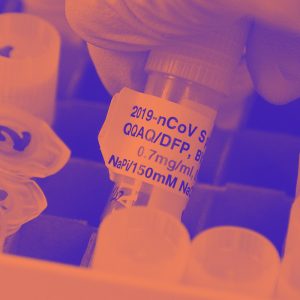Tech & Science dictionary
ChAdOx1 nCoV-19
What is ChAdOx1 nCoV-19?
ChAdOx1 nCoV-19 is a potential vaccine for the coronavirus. Early results from trials show that the vaccine is safe and produces an immune response against the virus that causes COVID-19.
Another name for ChAdOx1 nCoV-19 is AZD1222, used especially in the context of the vaccine’s co-development by the University of Oxford, Vaccitech, and AstraZeneca. ChAdOx1 nCoV-19 is especially used in the context of Oxford’s leading role in first developing the vaccine.
What does ChAdOx1 nCoV-19 mean?

Scientists abbreviate the names of vaccines, which can be long, complex, and technical. Even their abbreviations, however, can be confusing or intimidating to laypeople.
ChAdOx1 nCoV-19 is no exception—which, we’ll admit, looks like a computer-generated password or a cyberpunk or gamer screen name if we didn’t know any better.
✅ ChAdOx1 nCoV-19 is a chimpanzee (Ch) adenovirus-vectored vaccine (Ad), whose development was led by the University of Oxford (Ox). It has been shown to stimulate an immune response to nCoV-19, the novel coronavirus first identified in 2019.
Now, let’s unpack the phrase chimpanzee adenovirus-vectored vaccine.
- vaccine: a substance introduced into someone’s body to prevent them from getting a specific disease. It usually consists of a small amount of a killed, weakened, or otherwise modified version of a disease (such as a virus or bacterium).
- vector: the agent that acts as carrier or transporter of the virus, which is injected into a patient to trigger a response from their immune system to fight off disease pathogens.
- adenovirus: a type of that can cause respiratory and other illnesses in humans and other primates, including chimpanzees, from which ChAdOx1 nCoV-19 was specifically derived and is being used as the vaccine vector against COVID-19.
In conjunction with the spin-off biotechnology company Vaccitech, Oxford has developed more than one adenovirus-vectored vaccine, which it refers to as ChAdOx1 and ChAdOx2, hence the numeral 1 in ChAdOx1 nCoV-19.
You may recall that COVID-19 is the name of the disease caused by one type of coronavirus, which was newly detected (novel) in 2019. The name of the specific coronavirus that causes COVID-19 is severe acute respiratory syndrome coronavirus 2, abbreviated as SARS-CoV-2.
Want to learn more about vaccines, immunity, and COVID-19? We have many more helpful and informative resources. Dig deeper in our Vocab Builder on the history of the word vaccine. Learn more about immune responses in our article “What Are Antibodies, And Do They Kill Viruses?” And see how the pandemic got its name in our About This Word explainer on COVID-19.
Examples of ChAdOx1 nCoV-19
More information about ChAdOx1 nCoV-19
Vaccines generally take a long time to develop, as scientists need to ensure they are safe (don’t make patients sick) and efficacious (produce the desired immune response). To this end, scientists carry out a three-phase trial to test the vaccine, as the CDC explains:
During Phase I, small groups of people receive the trial vaccine. In Phase II, the clinical study is expanded and vaccine is given to people who have characteristics (such as age and physical health) similar to those for whom the new vaccine is intended. In Phase III, the vaccine is given to thousands of people and tested for efficacy and safety.
ChAdOx1 nCoV-19 is moving into Phase 2 and Phase 3 trials. Oxford University is partnering with the UK-based, international biopharmaceutical company AstraZeneca to scale up testing and manufacturing of the potential COVID-19 around the globe. Populations at high-risk of illness or death from COVID-19, such as people over the age of 65 and hospital workers, will be prioritized for the next trials.
So far, there have been well over 100 vaccine candidates for COVID-19, but none have been approved for prevention. As published online in the medical journal The Lancet on July 20, 2020, the initial results ChAdOx1 nCoV-19 are encouraging, positive news, but much more research is needed to determine how long the vaccine’s immune response lasts, how the vaccine affects vulnerable populations, and whether the vaccine can reduce and prevent infection.
In popular culture, some people have been making jokes about ChAdOx1 nCoV-19 resembles Chad, a slang term for a stereotypically masculine, sexually promiscuous young man.
Note
This is not meant to be a formal definition of ChAdOx1 nCoV-19 like most terms we define on Dictionary.com, but is rather an informal word summary that hopefully touches upon the key aspects of the meaning and usage of ChAdOx1 nCoV-19 that will help our users expand their word mastery.